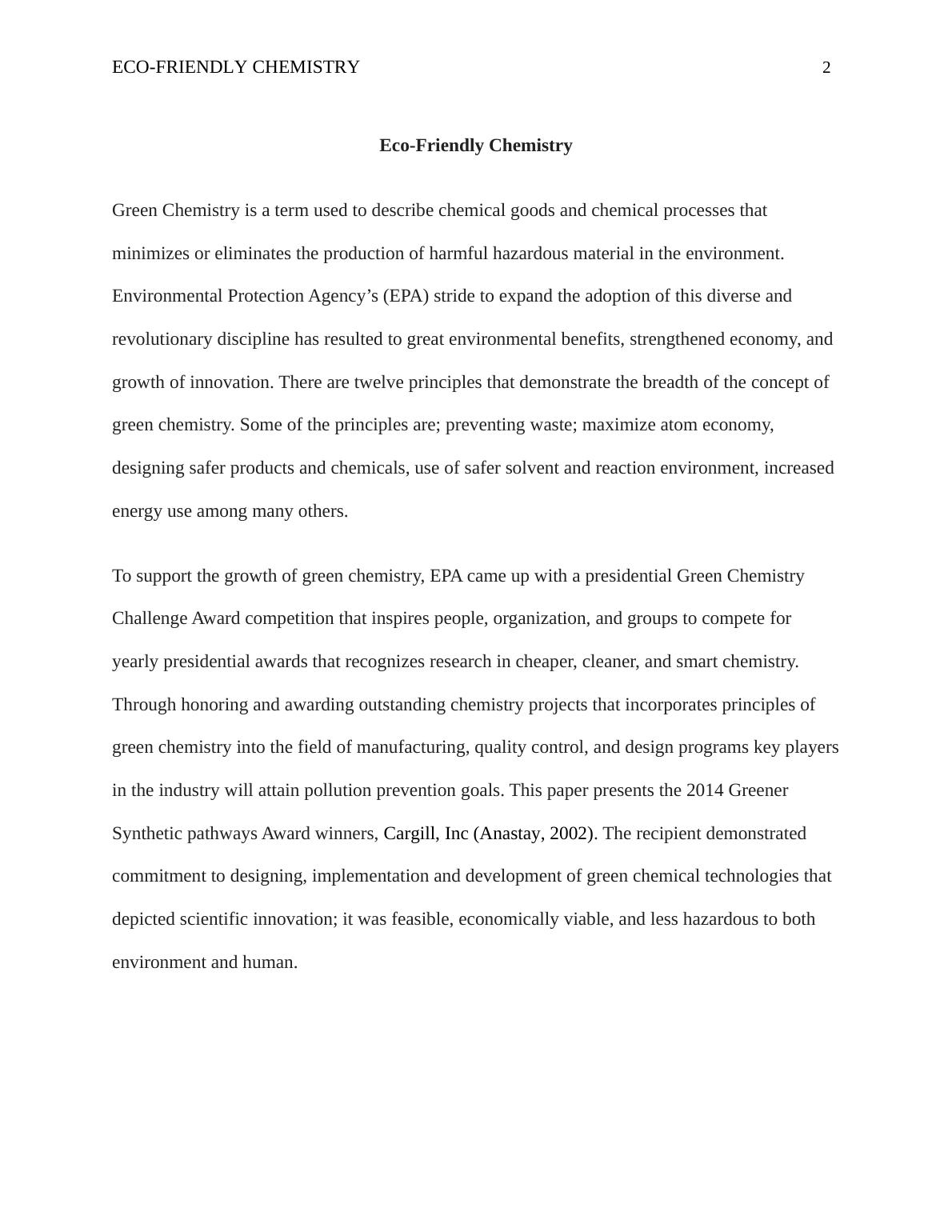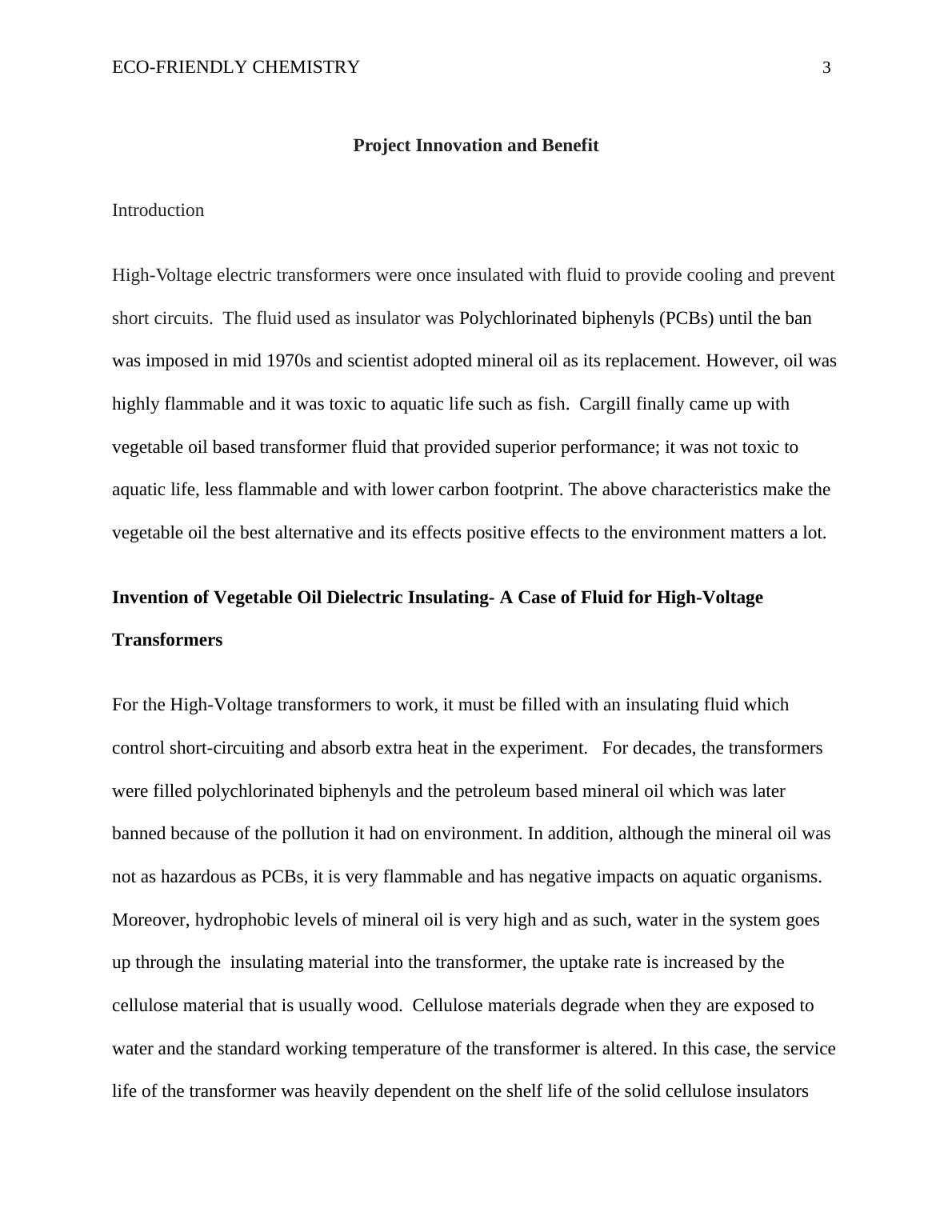Eco-friendly Chemistry Task
Added on 2022-08-25
7 Pages1653 Words15 Views
Running head: ECO-FRIENDLY CHEMISTRY 1
Eco-Friendly Chemistry
Name
Institution
Eco-Friendly Chemistry
Name
Institution

ECO-FRIENDLY CHEMISTRY 2
Eco-Friendly Chemistry
Green Chemistry is a term used to describe chemical goods and chemical processes that
minimizes or eliminates the production of harmful hazardous material in the environment.
Environmental Protection Agency’s (EPA) stride to expand the adoption of this diverse and
revolutionary discipline has resulted to great environmental benefits, strengthened economy, and
growth of innovation. There are twelve principles that demonstrate the breadth of the concept of
green chemistry. Some of the principles are; preventing waste; maximize atom economy,
designing safer products and chemicals, use of safer solvent and reaction environment, increased
energy use among many others.
To support the growth of green chemistry, EPA came up with a presidential Green Chemistry
Challenge Award competition that inspires people, organization, and groups to compete for
yearly presidential awards that recognizes research in cheaper, cleaner, and smart chemistry.
Through honoring and awarding outstanding chemistry projects that incorporates principles of
green chemistry into the field of manufacturing, quality control, and design programs key players
in the industry will attain pollution prevention goals. This paper presents the 2014 Greener
Synthetic pathways Award winners, Cargill, Inc (Anastay, 2002). The recipient demonstrated
commitment to designing, implementation and development of green chemical technologies that
depicted scientific innovation; it was feasible, economically viable, and less hazardous to both
environment and human.
Eco-Friendly Chemistry
Green Chemistry is a term used to describe chemical goods and chemical processes that
minimizes or eliminates the production of harmful hazardous material in the environment.
Environmental Protection Agency’s (EPA) stride to expand the adoption of this diverse and
revolutionary discipline has resulted to great environmental benefits, strengthened economy, and
growth of innovation. There are twelve principles that demonstrate the breadth of the concept of
green chemistry. Some of the principles are; preventing waste; maximize atom economy,
designing safer products and chemicals, use of safer solvent and reaction environment, increased
energy use among many others.
To support the growth of green chemistry, EPA came up with a presidential Green Chemistry
Challenge Award competition that inspires people, organization, and groups to compete for
yearly presidential awards that recognizes research in cheaper, cleaner, and smart chemistry.
Through honoring and awarding outstanding chemistry projects that incorporates principles of
green chemistry into the field of manufacturing, quality control, and design programs key players
in the industry will attain pollution prevention goals. This paper presents the 2014 Greener
Synthetic pathways Award winners, Cargill, Inc (Anastay, 2002). The recipient demonstrated
commitment to designing, implementation and development of green chemical technologies that
depicted scientific innovation; it was feasible, economically viable, and less hazardous to both
environment and human.

ECO-FRIENDLY CHEMISTRY 3
Project Innovation and Benefit
Introduction
High-Voltage electric transformers were once insulated with fluid to provide cooling and prevent
short circuits. The fluid used as insulator was Polychlorinated biphenyls (PCBs) until the ban
was imposed in mid 1970s and scientist adopted mineral oil as its replacement. However, oil was
highly flammable and it was toxic to aquatic life such as fish. Cargill finally came up with
vegetable oil based transformer fluid that provided superior performance; it was not toxic to
aquatic life, less flammable and with lower carbon footprint. The above characteristics make the
vegetable oil the best alternative and its effects positive effects to the environment matters a lot.
Invention of Vegetable Oil Dielectric Insulating- A Case of Fluid for High-Voltage
Transformers
For the High-Voltage transformers to work, it must be filled with an insulating fluid which
control short-circuiting and absorb extra heat in the experiment. For decades, the transformers
were filled polychlorinated biphenyls and the petroleum based mineral oil which was later
banned because of the pollution it had on environment. In addition, although the mineral oil was
not as hazardous as PCBs, it is very flammable and has negative impacts on aquatic organisms.
Moreover, hydrophobic levels of mineral oil is very high and as such, water in the system goes
up through the insulating material into the transformer, the uptake rate is increased by the
cellulose material that is usually wood. Cellulose materials degrade when they are exposed to
water and the standard working temperature of the transformer is altered. In this case, the service
life of the transformer was heavily dependent on the shelf life of the solid cellulose insulators
Project Innovation and Benefit
Introduction
High-Voltage electric transformers were once insulated with fluid to provide cooling and prevent
short circuits. The fluid used as insulator was Polychlorinated biphenyls (PCBs) until the ban
was imposed in mid 1970s and scientist adopted mineral oil as its replacement. However, oil was
highly flammable and it was toxic to aquatic life such as fish. Cargill finally came up with
vegetable oil based transformer fluid that provided superior performance; it was not toxic to
aquatic life, less flammable and with lower carbon footprint. The above characteristics make the
vegetable oil the best alternative and its effects positive effects to the environment matters a lot.
Invention of Vegetable Oil Dielectric Insulating- A Case of Fluid for High-Voltage
Transformers
For the High-Voltage transformers to work, it must be filled with an insulating fluid which
control short-circuiting and absorb extra heat in the experiment. For decades, the transformers
were filled polychlorinated biphenyls and the petroleum based mineral oil which was later
banned because of the pollution it had on environment. In addition, although the mineral oil was
not as hazardous as PCBs, it is very flammable and has negative impacts on aquatic organisms.
Moreover, hydrophobic levels of mineral oil is very high and as such, water in the system goes
up through the insulating material into the transformer, the uptake rate is increased by the
cellulose material that is usually wood. Cellulose materials degrade when they are exposed to
water and the standard working temperature of the transformer is altered. In this case, the service
life of the transformer was heavily dependent on the shelf life of the solid cellulose insulators

End of preview
Want to access all the pages? Upload your documents or become a member.
